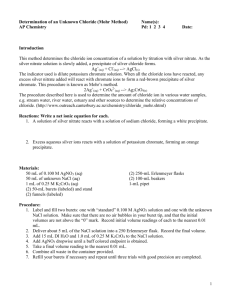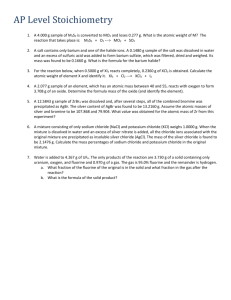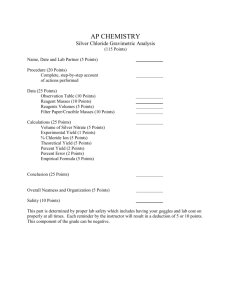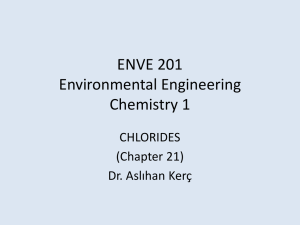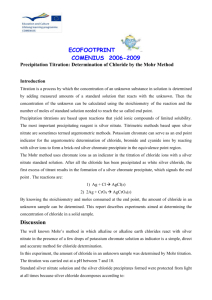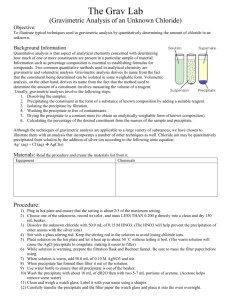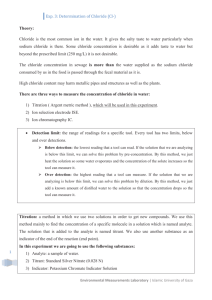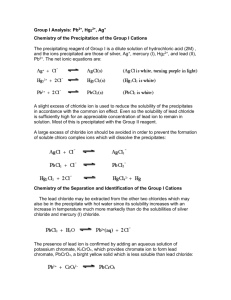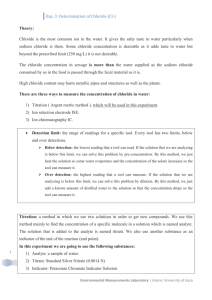EXPERIMENT III
advertisement
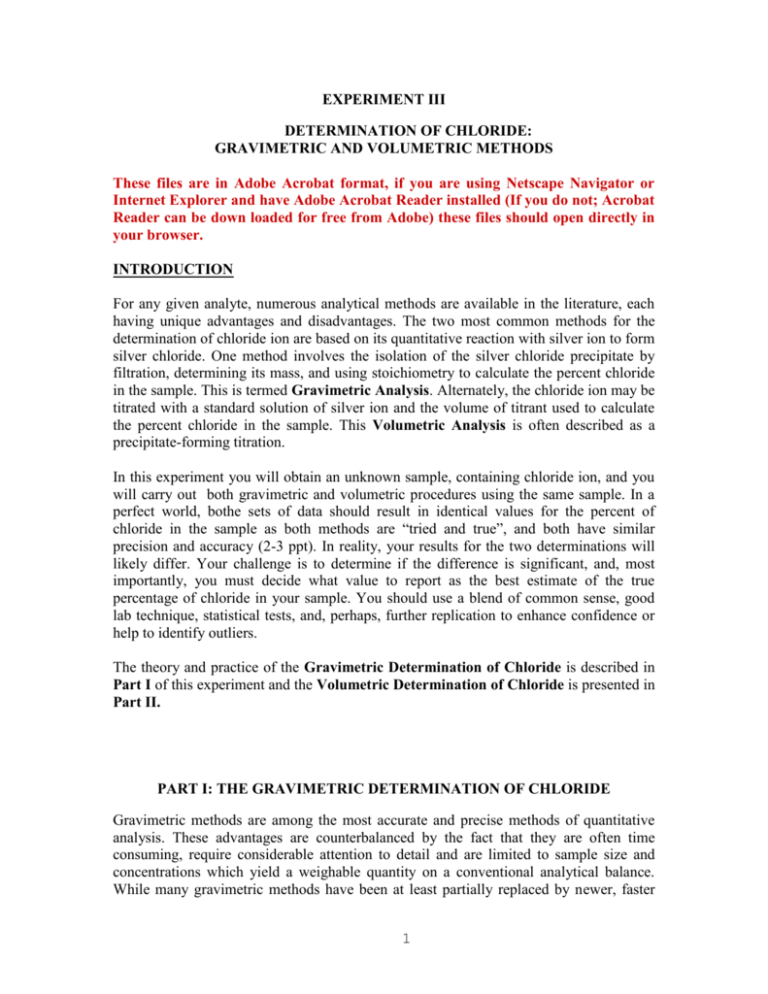
EXPERIMENT III DETERMINATION OF CHLORIDE: GRAVIMETRIC AND VOLUMETRIC METHODS These files are in Adobe Acrobat format, if you are using Netscape Navigator or Internet Explorer and have Adobe Acrobat Reader installed (If you do not; Acrobat Reader can be down loaded for free from Adobe) these files should open directly in your browser. INTRODUCTION For any given analyte, numerous analytical methods are available in the literature, each having unique advantages and disadvantages. The two most common methods for the determination of chloride ion are based on its quantitative reaction with silver ion to form silver chloride. One method involves the isolation of the silver chloride precipitate by filtration, determining its mass, and using stoichiometry to calculate the percent chloride in the sample. This is termed Gravimetric Analysis. Alternately, the chloride ion may be titrated with a standard solution of silver ion and the volume of titrant used to calculate the percent chloride in the sample. This Volumetric Analysis is often described as a precipitate-forming titration. In this experiment you will obtain an unknown sample, containing chloride ion, and you will carry out both gravimetric and volumetric procedures using the same sample. In a perfect world, bothe sets of data should result in identical values for the percent of chloride in the sample as both methods are “tried and true”, and both have similar precision and accuracy (2-3 ppt). In reality, your results for the two determinations will likely differ. Your challenge is to determine if the difference is significant, and, most importantly, you must decide what value to report as the best estimate of the true percentage of chloride in your sample. You should use a blend of common sense, good lab technique, statistical tests, and, perhaps, further replication to enhance confidence or help to identify outliers. The theory and practice of the Gravimetric Determination of Chloride is described in Part I of this experiment and the Volumetric Determination of Chloride is presented in Part II. PART I: THE GRAVIMETRIC DETERMINATION OF CHLORIDE Gravimetric methods are among the most accurate and precise methods of quantitative analysis. These advantages are counterbalanced by the fact that they are often time consuming, require considerable attention to detail and are limited to sample size and concentrations which yield a weighable quantity on a conventional analytical balance. While many gravimetric methods have been at least partially replaced by newer, faster 1 techniques, there remain several situations where the only suitable analytical techniques are gravimetric. For this reason you should become experienced and competent with gravimetric techniques, such as the gravimetric determination of chloride. THEORY Addition of a solution containing silver ion [usually an aqueous silver nitrate (AgNO3) solution] to a dissolved sample containing chloride ion will quantitatively precipitate the chloride ion as solid silver chloride (AgCl), due to the small solubility product constant of silver chloride (ksp = 1.82 x 10-10). The precipitate may be isolated from solution by filtration, the material dried, weighed and the percent chloride (% Cl-) calculated from the stoichiometry of the reaction: A g (aq) + C l (aq) A g C l(s) In addition to possible interferences common to all gravimetric methods, the presence of any other halide will cause high results since they produce a silver halide which is even more insoluble than silver chloride. Also, silver chloride is light sensitive and excessive photodecomposition will produce erroneous results, according to the reaction: AgC l(s) Ag(s) + 1 2 Cl2 (g) The precipitate becomes violet-purple, due to the presence of finely divided silver metal, and results will be low. If silver ion (Ag+) is present, in addition to the above, the following reaction will also occur as a result of the photodecomposition reaction: hv 3Cl 2 (g) + 3H 2 O(l) + 5Ag (aq) 5AgCl(s) + ClO 3- (aq) + 6H (aq) If this reaction predominates, the results will be high. To minimize such errors, it is recommended that unnecessary exposure to light be avoided. PROCEDURE Preparation of the Sample for Analysis Obtain approximately 5 g of an unknown sample from your instructor in a clean, dry, and properly labeled weighing bottle. Dry the unknown material in the microwave oven using medium power for two minutes. Weigh accurately, after cooling in a desiccator for approximately 30 minutes, triplicate samples of approximately 0.5 g into numbered 400mL beakers. Dissolve in deionized water and dilute each to approximately 150 mL volume. Add approximately 0.5 mL of reagent-grade concentrated nitric acid (HNO3). Preparation of Crucibles Clean and suitability mark three sintered glass crucibles of medium (M) porosity. Your instructor will outline for you the best method of cleaning the crucibles, as the method of cleaning is dependent upon their past history. Then bring the crucibles to constant weight in the microwave oven using medium power. The first heating should be at least 30 seconds; let the crucible cool, heat for a further 30 seconds, cool, then finally heat for 4 2 minutes. Re-heat for 2-minute periods until constant weight is obtained. The weight should become constant to within ±0.3 mg. Preparation of Precipitating Reagent An aqueous solution of 0.5 M silver nitrate (AgNO3) is available in the laboratory. Assuming the unknown to be pure sodium chloride, calculate the volume of the silver nitrate solution required to just precipitate all chloride ion in each sample. Include 10% excess in the final volume to compensate for the fact that the calculation is based on an assumption that could be incorrect. Precipitation Add the calculated amount of silver nitrate solution slowly to each sample, preferably from a buret, with adequate stirring, (remember each sample will require a different volume of silver nitrate solution as each sample is of a different weight). Cover each solution with a watch glass (remember to leave the stirring rod in the beaker), heat each solution to nearly boiling (hot plate) to coagulate the silver chloride precipitate. Let each solution cool and settle, then test for complete precipitation as demonstrated by the instructor. Add more precipitating reagent, if necessary, and re-check for complete precipitation. Allow each solution to digest (in the dark) at least 1-2 hours, or, if necessary overnight. Filtration Filter each solution through the corresponding sintered glass crucible, adhering to the guidelines for proper filtration, presented by the instructor. Be certain to "police" each beaker to assure quantitative transfer. Wash each precipitate with a solution of 1:500 nitric acid/water (nitric acid is added to prevent peptization) until the washings give a negative test for Ag+. After you have a negative test for Ag+, place the sintered glass crucible in the filtration apparatus and pull a vacuum on it for several minutes. It is important that you get the filtrate as dry as possible before drying in an oven. NOTE: Washings may be tested for their silver ion content by using the following procedure. After you have filtered your precipitate and washed with an initial amount of wash solution, carefully remove the filter crucible and touch the base to the surface of a clean, dry watch glass. Several drops of the residual wash will transfer to the watch glass. If this does not occur, add a small amount (1 or 2 mL) of wash solution to the filter crucible and wait for gravity to cause the transfer of some of the wash solution. Add 2-3 drops of 12 M HCl to the wash solution on the watch glass. The formation of a cloudy white solution indicates the presence of Ag+ in the wash solution. If this occurs, reassemble and wash with ~10 mL of wash solution and retest. Repeat until a negative test for Ag+ is obtained. 3 Drying the Crucibles Place the crucibles in a beaker covered with a ribbed watch glass (as with the empty crucibles). Dry in the microwave oven at medium power for 30 seconds; let the crucible cool, heat for a further 30 seconds and cool, then finally heat for 4 minutes, cool in a desiccator and weigh. Reheat for 2-minute periods until constant weight is obtained. Cleaning the Crucibles After completion of the analysis, remove carefully, without damaging the sinter, the cake of silver chloride from the crucible(s) and place the cake in the silver waste bottle. Place the crucibles in a beaker and fill each crucible with concentrated aqueous ammonia solution (Do this in a hood). Allow the crucibles to sit until all the silver chloride has been dissolved by the ammonia. Rinse each crucible with several portions of deionized water and dry in a microwave oven at medium power for 4 minutes or until dry. CALCULATION OF RESULTS Calculate your results as the % Cl- in your sample. Be certain to report each individual value, the mean value, the absolute deviation of each value from the mean, the relative average deviation in parts per thousand, the standard deviation and the confidence interval at an appropriate confidence level. A relative average deviation of > 5 ppt (5 parts per thousand) should be considered unsatisfactory. PART II: THE VOLUMETRIC DETERMINATION OF CHLORIDE Precipitate-forming titrations are not common. However, they are widely used for determination of the halides, chloride (Cl-), bromide (Br-) and iodide (I-), using silver nitrate (AgNO3) as the titrant. In this part of the experiment, chloride will be determined by titration with silver nitrate using dichlorofluorescein as an indicator. This is commonly known as Fajan's Method. THEORY Chloride present in a sample is quantitatively insoluble in a solution containing excess of silver ion: Ag+(aq) + Cl- (aq) AgCl(s) 4 Ksp = 1.82 x 10-10 This reaction is the basis of a gravimetric procedure described in Part I of this experiment. The same determination may be accomplished volumetrically if a standard solution of Ag+ is available. The end point of the reaction may be determined through the use of an adsorption indicator, dichlorofluorescein. Its function may be described as follows: If the reaction is run in neutral or basic solution some of the indicator will dissolve to form the dichlorofluorescinate anion, which is represented as In-. Before the equivalence point, with Ag+ as titrant, excess Cl- is present in solution. The excess Cl- is adsorbed onto the precipitate particles formed and the indicator anion is repelled by the negativelycharged precipitate. Ag+(aq) + 2Cl-(aq) AgCl:Cl (s) At the equivalence point, there is little or no excess Cl-, and just beyond the equivalence point Ag+ is in excess and becomes the primary adsorbed ion. The charge on the precipitate changes from negative to positive and the indicator anion is adsorbed. + AgCl:Cl-(s) + Ag+(aq) AgCl:Ag (s) + Cl (aq) + AgCl:Ag+(s) + In-(aq) AgCl:Ag In (s) yellow rose-pink The color change is: yellow rose-pink It is believed that the indicator anion (yellow) forms a complex ion with Ag+, adsorbed on the silver chloride precipitate, which alters its light-absorbing properties, and hence its color. The indicator function is critically dependent on the availability of a large precipitate surface area to allow adsorption. The greatest surface area results from a precipitate comprised of very small particles (colloidal). Stabilization of these colloidal particles (recall that a colloid has a very high surface-to-volume ratio) is accomplished by adding a protective colloid, such as dextrin. It is important that the titration be conducted quickly in diffuse light as photodecomposition of the silver chloride renders the solution purple, making it difficult to discern the pale pink end point signal from the purple background. PROCEDURE Preparation of a Standard Silver Nitrate Solution Obtain from the instructor approximately 8.5 g of AgNO3 in a clean, dry, weighing bottle. Grind the contents to a fine powder with an agate mortar and pestle. Return the AgNO3 to the weighing bottle, dry in a microwave oven at medium power for 2 minutes, and accurately weigh, by difference, the contents into a 500-mL volumetric flask. 5 Dissolve with deionized water and dilute to the mark. Store in a dark area and calculate the molarity of the solution. Preparation of the Sample for Analysis Using the unknown chloride sample from part 1, accurately weigh three samples of the unknown into three 250-mL Erlenmeyer flasks (the sample size should be approximately 0.3 g). Add approximately 50 mL of deionized water to each flask and swirl to dissolve. Add 10 mL of a 2% dextrin suspension, 5 drops of dichlorofluorescein indicator, and titrate each sample to the rose-pink end point. CALCULATION OF RESULTS Calculate your results as the % Cl- in your sample. Be certain to report each individual value, the mean value, the absolute deviation from the mean of each value, the relative average deviation in parts per thousand, the standard deviation and the confidence interval at an appropriate confidence level. 6

